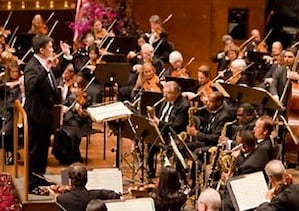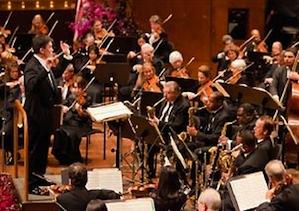
Photo by Chris Lee
Visitors from the east arrived bearing gifts over the weekend at Davies Symphony Hall. Under Music Director Alan Gilbert, the New York Philharmonic performed concerts Sunday and Monday as part of the San Francisco Symphony’s American Orchestra Series, and the rewards — particularly in the introduction of a brilliant new concerto by Finnish composer Magnus Lindberg — were manifold.
These appearances, part of a six-city, seven-concert tour, marked the orchestra’s first performances in Davies Hall since 1999, and its first national tour under Gilbert, who was named the N.Y. Philharmonic’s music director in September 2009.
Sunday’s program, which featured pianist Yefim Bronfman in Lindberg’s Piano Concerto No. 2, also included Tchaikovsky’s Symphony No. 4 in F Minor and Dvořák’s “Carnival” Overture. On Monday, the orchestra returned with Berlioz’s Overture to Le Corsaire, Debussy’s La Mer, Ravel’s La Valse, and Bartók’s Violin Concerto No. 1, with Glenn Dicterow as soloist.
Founded in 1842, the New York Philharmonic — the oldest orchestra in the U.S., and currently one of the oldest in the world — remains a formidable, top-tier ensemble. Its sound — big, sleek, and muscular — is distinctive and virtuosic. Gilbert, three years into the orchestra’s leadership role, is a fairly low-key podium presence. Yet these performances spoke for themselves. The conductor appears to have forged an extremely responsive ensemble, and each piece on these programs, from familiar scores to new works, came across sounding well-rehearsed and vibrant.
Nowhere were the results as arresting as in Sunday’s performance of Lindberg’s Piano Concerto No. 2. Gilbert and the orchestra premiered the work earlier this month in New York, and on this program, it emerged a work of tremendous power and considerable allure.
Lindberg has said he was inspired by Ravel’s Piano Concerto for the Left Hand, and this score does boast some of that earlier work’s flamboyant character. Composed in three uninterrupted movements, it begins with a somber, elemental introduction that rises up from the piano’s low register. The soloist negotiates a dense thicket of tangled chords punctuated by percussion. Sudden rests surge with tension.
You can hear echoes of Ravel (and Rachmaninov, and Gershwin) in the gorgeous orchestral harmonies, and in the piano’s cascading lines. Yet there’s a deeply mysterious aspect to the score, as well. This is music that invites the listener to reverie: Ravel glimpsed through a kind of dream-lens. Over its 30-minute length, the concerto yielded a mesmerizing study in contrasts: a work that looks back fondly to early 20th-century Romanticism, while contemplating a dark, unknowable future.
Conductor and Soloist Performing as One
Gilbert, who named Lindberg to a three-year term as the orchestra’s composer in residence in 2009 (this concerto is the composer’s fourth and final work in that post), clearly believes in the score, and he led a gripping performance on Sunday during which the orchestra’s brass and percussion sections were exemplary. And Bronfman was astonishing, negotiating the piano part’s aggressive outbursts, propulsive runs, and jazzy fantasy flights with seamless mastery.
The conductor appears to have forged an extremely responsive ensemble.
If Tchaikovsky’s Fourth Symphony didn’t register with quite the same impact, it was nonetheless a fully realized performance. Gilbert, apparently, sides with those who choose to refrain from overheating this composer’s music; his reading was beautiful, to be sure, but also rather cool and cerebral. Still, the orchestra played with admirable energy and crisp definition.
There was no arguing with Dvořák’s “Carnival” Overture, which opened the program on a rush of brisk, characterful playing, or with the encore, a delicate, luminous performance of Leonard Bernstein’s “Lonely Town” from the musical On the Town.
The highlight of Monday’s program was Bartók’s Violin Concerto No. 1. Gilbert drew a glowing, warm-toned performance from the orchestra, and Dicterow, the Philharmonic’s longtime concertmaster, was the ideal soloist. He’s not a showy performer, but he advanced Bartók’s long, rapturous melodies with tonal splendor and an ear for nuance. Like Sunday’s performance of the Lindberg concerto, it was the kind of music-making that holds the audience in thrall.
The Lindberg concerto yielded a mesmerizing study in contrasts.
The evening began with an outsized performance of Berlioz’ Overture to the ballet Le Corsaire, which sounded both exuberant and handsomely shaded under Gilbert’s direction. After intermission, Gilbert turned to La Mer. Here, what impressed were the superb orchestral balances, the graceful give-and-take between the sections — the poised violins, the shapely low strings, the buoyant woodwinds, the elegant, well-tuned brass — and the precise rhythmic definition the conductor elicited. Gilbert applied judicious dabs of color and texture, and Debussy’s eddying, light-refracting score once again sounded essential.
So, too, did La Valse. Ravel’s score is a favorite on orchestral programs, but to these ears, it’s never sounded quite so extravagant, so robust, so weighty. For the encores, Gilbert led a vivacious, effervescent reading of Emmanuel Chabrier’s España. Then he cued the brass section, which rose to play the raucous rag turned Dixieland standard, That’s a Plenty. And so it was — the last in a wealth of delightful surprises in this historic visit.

